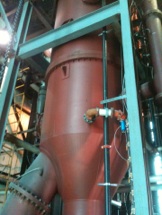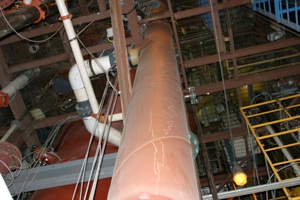 |
8-in (20-cm)-Diameter CFB PSRI’s Circulating Fluidized Bed (CFB) Test Facility contains a riser that is 8 inches (20 cm) in diameter and 72 ft (22 m) high. It is extensively instrumented with differential pressure transmitters to determine local solids holdups and axial pressure profiles. A gamma-ray densitometer probe is used to measure local solids density as a function of radial position at three locations in the riser - 13, 30, and 44 ft (4, 9.2, and 13.4 m) above the solids entry point. Extraction probes at the same locations allow local determination of mass flux as a function of radial position. The unit consists of a 3-ft (0.9-m)-diameter fluidized storage hopper, an 8-in (20-cm)-diameter standpipe approximately 55 ft (16.8 m) long, the 8-in (20-cm)-diameter riser, first and second-stage cyclones, and diplegs to route the solids collected by the cyclones back into the fluidized storage hopper. A diverter valve in the first-stage cyclone dipleg allows solids to be diverted into a collection hopper on load cells so that the solids flow rate can be measured. The facility operates at ambient temperature and pressure. It can operate at gas velocities of up to 70 ft/s (21.3 m/s) and at solids fluxes in the riser of 200 lb/s-ft2 (980 kg/s-m2). |
|
12-in (30-cm)-Diameter CFB Three 12-inch (0.3-m) diameter by 50 ft (15 m) tall risers are used to recycle solids around a CFB loop. Most of the PSRI circulating loops contain fluidized beds that allow wide range solids circulation rates. These units can be used to conduct turbulent fluidized bed tests, or tests in large diameter circulating fluidized beds. It is an ambient temperature and pressure facility. The risers in this facility can operate at velocities of up to 70 ft/s (21m/s) and solid fluxes of up to 180 lb/s-ft2 (880 kg/s-m2). All the risers contain Plexiglas sections so that the solids motion in the bed can be visually monitored. |
|
 |
36-in (91-cm)-Diameter CFB The PSRI CFB test facility also contains a large CFB with a 36-inch (0.91-m) diameter by 90 foot (27 m) tall riser with a 30-inch (0.76-m) diameter standpipe. The unit even has an 8-foot (2.4-meter)-diameter stripper/reactor section. Equipped with an array of large cyclones, the unit can handle high velocities and high fluxes similar to that found in industrial operations. Both the riser and the standpipe have been used separately as tall fluidized beds. |
 |
Standpipe Test Unit |
PSRI Circulating Fluidized Bed Test Units
©
1971 - 2023
Particulate Solid Research, Inc
PSRI Restricted: Authorized Access Only

